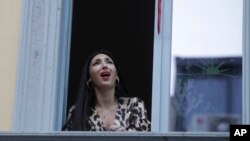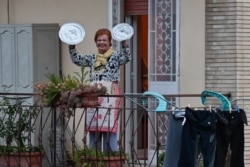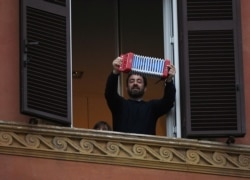The world may be shutting down but there’s still time for music in Italy, even if the concert halls are closed.
Across Italy, from the Tuscan town of Siena to the southern city of Naples, Italians are refusing to be silenced. Overnight, neighbors started singing together, leaning out through open windows or standing on their balconies — a collective act of civic solidarity and coronavirus defiance.
In Siena they started singing a traditional Tuscan folk song, Il Canto della Verbena (And While Siena Sleeps), one of the town’s most cherished melodies and sung since the Middle Ages. The back-and-forth choruses echoed down the narrow, deserted street of the medieval town. “Long live Siena, the most beautiful of cities.”
A video posted on social media of the singing went viral, with many on Twitter saluting the singing as a “beautiful” act of humanity.
“People of my hometown Siena sing a popular song from their houses along an empty street to warm their hearts during the Italian COVID-19 lockdown,” wrote one person on Twitter.
Others said that despite being separated in their homes, Italians were showing they remained together. Siena’s singing prompted other towns to follow. In Naples, quarantined Italians in apartment blocks in the Casoria district of the city joined in singing in defiance of the deadly disease sweeping the country.
In one video they can be heard singing the local soccer chant: “People like us will never give up; people like us will never give up; people like us; people like us; people like us will never give up. Come on Italy! Come on Naples! Forever!”
Naples escaped the first waves of coronavirus cases, documenting just 95 infections so far, but as with the rest of Italy, Neapolitans are locked down on a “stay-at-home” rule imposed by the Italian government to try to retard the spread of COVID-19. As of Thursday, Siena had 29 confirmed cases, according to the country’s Civil Protection Agency.
Italy’s death toll rose above 1,260 Friday, with more than 17,660 confirmed cases. The epicenters were still mainly in the north of the country, in the regions of Lombardy, Veneto and Emilia-Romagna. Siena had 41 confirmed cases, and Naples had 140.
The singing came soon after the country’s Foreign Minister Luigi Di Maio praised Italians for observing the national lockdown, which tightly restricts people’s movements.
All shops, aside from food stores and pharmacies, and all schools are shuttered.
He told broadcasters: “Our grandfathers were drafted to go to war; we're being asked to stay at home. ... If a doctor and a nurse can work for 24 hours nonstop, we can give up leaving our own home. The huge majority of citizens are respecting the rules.”
Italian officials say the effectiveness of the national quarantine will depend on two crucial factors — the willingness of Italians to comply with the rules and how long the lockdown can be sustained in the face of mounting economic and social costs. Privately, they acknowledge there are risks of civil unrest, if the shutdown has to be prolonged and doesn’t start showing benefits within the next two weeks in terms of a decline in the rate of infections.
Italy has followed the lockdown approach China adopted to quell the spread of COVID-19 in Hubei province, the origin of the virus. Other European countries have started to ramp up to varying degrees their efforts to slow the disease but have not been as radical as Italy, Europe’s coronavirus epicenter, and have opted for more modest restrictions.
Like Italy, several countries, including France, Spain, Greece, Denmark and Ireland, have closed schools and universities and banned large gatherings. They are poised to follow Italy’s lockdown example, their officials say, if the rise in cases in their countries can’t be slowed, fearing otherwise huge spikes in infections will overwhelm their hospitals and lead to more deaths.
The head of the World Health Organization said Friday that Europe had now become the epicenter of the coronavirus pandemic.
Officials elsewhere in Europe have taken note that in a matter of two weeks, the explosion of cases in Lombardy, one of the wealthiest regions in Italy, exhausted the hospitals there. Lombardy boasts one of the most efficient and well-funded health care systems not just in Italy, but also in Europe. This week, the region’s health care coordinators admitted to reporters that Lombardy’s hospitals were “one step from collapse.”
Other officials have been warning that doctors and nurses are close to burnout after working around the clock for weeks.
Britain has remained an outlier and has held back from introducing the more restrictive measures being seen on mainland Europe.
The number of confirmed cases in the the country reached 590 Thursday — up by 134 in 24 hours. But the British government’s chief scientific adviser, Patrick Vallance, has admitted publicly the actual number of people infected at the moment could be between 5,000 and 10,000.
British Prime Minister Boris Johnson on Thursday confirmed the government was entering the second phase of its response to COVID-19 — moving from trying to contain the virus to retarding its spread. But Johnson has declined so far to close schools and universities or ban large gatherings.
Opposition parties and some from Johnson’s own ruling Conservative Party have questioned why Britain is out of line with many other countries where schools have been closed and cities placed on lockdown. They also have called for independent scientists to be able to scrutinize the data that have led Downing Street to proceed more slowly.
Gordon Brown, a former prime minister, said Friday that “fears are still growing for our safety; for all the brilliance of Britain’s medics, the government still seems behind the curve.”
Vallance told Britain’s Sky News that Downing Street was moving more slowly than other governments because Britain was “a little bit behind” where the coronavirus outbreak is in other European states. He said Britain had managed to slow the rate of infection because of early action in tracing and isolating those infected.
“What we don't want to do is to get into knee-jerk reactions where you have to start doing measures at the wrong pace because something's happened," Vallance added.




